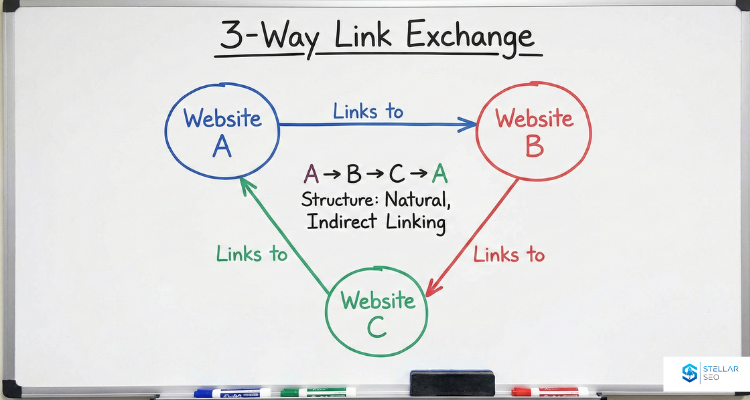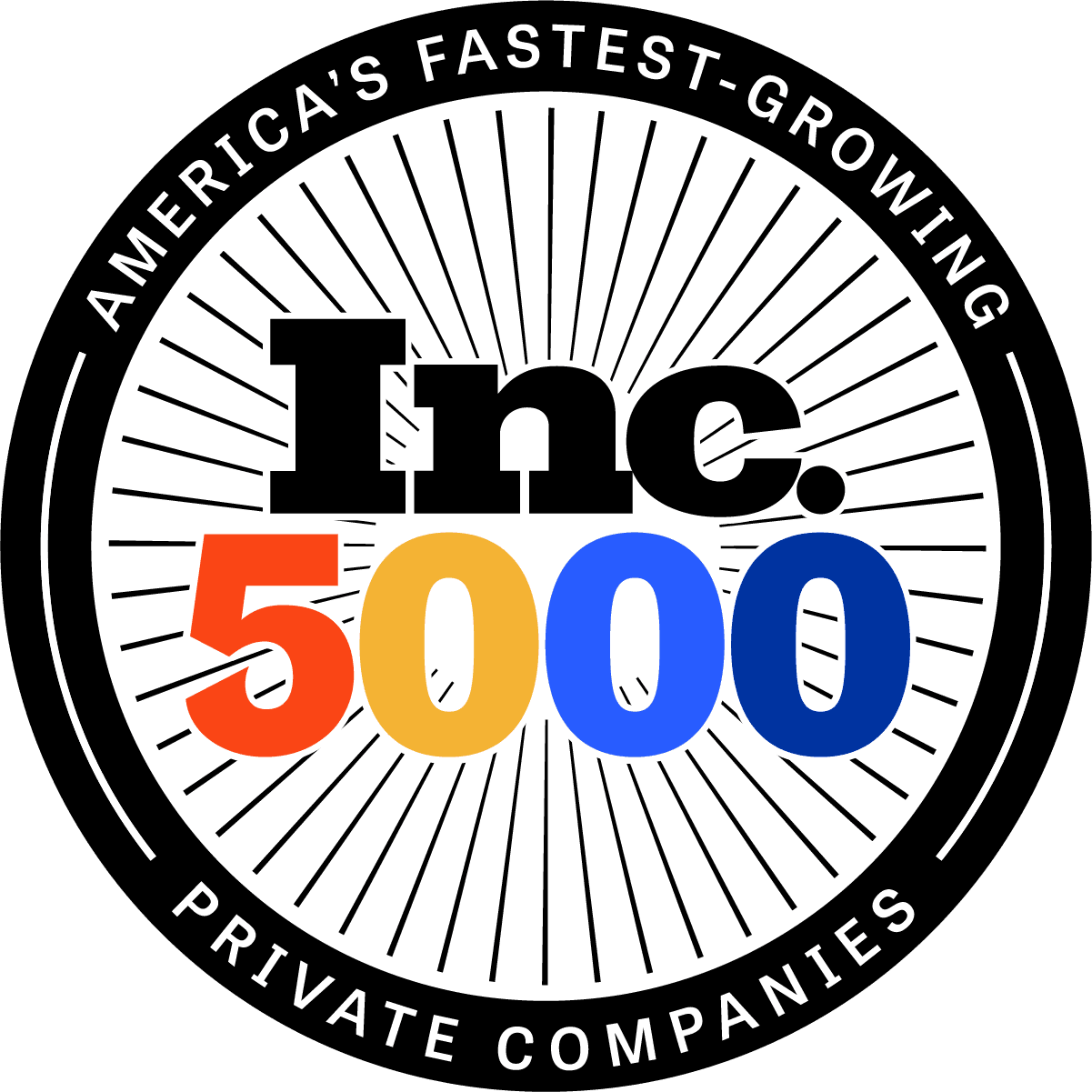Link exchanges still work, but not for the reasons most SEO guides explain.
Search engines no longer evaluate links in isolation. Google, and the AI systems layered on top of it, assess how consistently a website is referenced, categorized, and reinforced across the web.
That shift has changed how link exchanges should be approached.
Done strategically, link exchanges can reinforce authority, improve visibility, and support long-term growth. Done carelessly, they can create risk, leave an obvious footprint, or dilute trust signals. The difference comes down to relevance, structure, and execution.
This guide breaks down how link exchanges work today, when they still make sense, where they go wrong, and how to use them safely as part of a modern SEO and link-building strategy.
What is a Link Exchange?
A link exchange is when two websites agree to link to each other. This is also referred to sometimes as reciprocal linking. More complex exchanges, such as three-way structures, are covered later in this guide.
How Links Lead to Growth?
Search engines are designed to reward sources that demonstrate trust beyond their own site. When respected, topically aligned websites reference your content, those off-site signals help establish legitimacy and reinforce where your brand belongs within its niche.
The impact of this is measurable. In the license and education space, a Stellar SEO client increased organic traffic by 122.6 percent within one year by strengthening its backlink profile with relevant, editorial placements.
Not all links contribute equally. A single contextual link from an authoritative, niche-relevant website can carry more value than dozens of low-quality mentions. Authority, placement, and relevance matter far more than raw link count.
High-quality links come from websites that make sense for your business and are trusted within the same topical ecosystem. Links placed in spam-heavy environments, irrelevant communities, or low-quality directories provide little value and can weaken overall trust signals.
Avoiding a Link Scheme
Low-quality links do more than fail to help. Manipulative tactics, often referred to as link schemes, can actively weaken your SEO performance.
Link schemes attempt to inflate rankings through exchanged links that provide no real value to users. This often includes irrelevant cross-industry links, such as SaaS companies linking to a garden store’s blog, or backlinks placed on pages where they do not belong.
Common examples include link farms, public blogging networks (PBNs), and automated link placements. These patterns are easy for search engines to identify and can lead to ranking suppression rather than improvement.
When evaluating potential link exchange partners, look beyond surface metrics. Review their existing backlinks, content quality, and overall relevance. Strong partners publish clear, useful content and earn links from reputable, niche-aligned websites. Weak partners accept links indiscriminately and offer little editorial oversight.
Link exchanges work best when approached as long-term relationships, not transactions. Just as you would avoid unreliable vendors, you should avoid associating your site with questionable domains.
Are Links Exchanges Safe in 2026?
If you ask Google, the answer is black-and-white. Their documentation explicitly warns against “excessive link exchanges” and “partner pages exclusively for the sake of cross-linking,” categorizing them as link schemes intended to manipulate PageRank.
But if you work in SEO, you know the reality is grey.
The issue isn’t that websites link to each other; it’s the scale and the intent behind those links. Google’s algorithm is hunting for patterns of manipulation—automated swaps, irrelevant footprints, and low-quality networks. It is not hunting for two legitimate businesses in the same industry referencing each other’s resources.
At Stellar SEO, we don’t view link exchanges as “safe” or “unsafe.” We view them through the lens of risk management.
The Difference Between a Scheme and a Partnership
To mitigate risk, you must differentiate between a transactional link scheme and a strategic partnership.
-
The Scheme (High Risk): You trade links with a site solely to inflate metrics. There is no topical overlap, the content is thin, and the site exists primarily to sell outbound links. This leaves a clear algorithmic footprint that AI systems can easily identify and devalue.
-
The Partnership (Low Risk/High Value): You exchange visibility with a brand where the association makes business sense. The link drives qualified referral traffic, reinforces your entity’s standing in the niche, and is editorially justified.
If the link would provide business value (brand awareness, traffic, trust) even if Google didn’t exist, the risk of a penalty is negligible.
Risk Mitigation Through Proper Screening
The most effective way to insulate your site from risk is rigorous screening. Most “unsafe” link exchanges happen because the vetting process relies on surface-level metrics like Domain Rating (DR) rather than editorial quality.
To ensure safety, we apply a strict editorial standard to any potential partner:
-
Strict Editorial Standards: Does the partner site reject low-quality content? If they publish anything sent to them, their outbound link profile is likely toxic. You want partners who are difficult to get links from.
-
Traffic Integrity: Does the site have a consistent history of organic traffic from relevant geographies? Sudden spikes or drops often indicate previous algorithmic penalties or bot traffic.
-
Topical Alignment: Does the exchange reinforce your site’s topical authority? A law firm linking to a marketing agency makes sense; a law firm linking to a crypto blog does not.
The Verdict on Safety
Link exchanges are only dangerous when executed carelessly or aggressively.
If you treat links as a commodity to be traded in bulk, you will eventually trigger a filter. But if you treat link exchanges as a byproduct of legitimate business relationships, vetted for quality and relevance, they remain a powerful, secure method for building authority in a way that modern search engines reward.
Link Exchanges in the Age of AI Search
Link exchanges are no longer evaluated only by traditional ranking systems. They now influence how large language models like Google Gemini, ChatGPT, and other AI search systems understand brand relationships.
Modern AI systems build meaning through entity association, not just links in isolation. When two authoritative websites in the same space reference each other in a natural, editorial context, AI systems reinforce the idea that these brands belong in the same semantic category.
For example, if an established SEO agency is consistently mentioned alongside well-known SEO tools, publications, or platforms, AI models begin to associate that agency with the broader “SEO authority” entity. This is especially true on curated content such as “Best SEO Tools,” “Top Marketing Agencies,” or industry comparison pages.
In this context, link exchanges are less about manipulating rankings and more about training AI systems how to categorize your brand. Reciprocal links on relevant, high-quality pages help reinforce topical alignment, niche authority, and brand legitimacy across both search engines and AI-driven discovery platforms.
This is why modern link exchanges work best when they occur between sites that already belong in the same conceptual neighborhood, rather than random websites trading links for convenience.
What to Look At When Considering a Link Exchange?
Link building is a significant part of SEO, but organic rankings are not the only benefit.
If you get mentioned on popular, well-established sites, they can help you build brand recognition, trust, and referrals.
Quick Vetting Checklist for Safe Link Exchanges
Before agreeing to any link exchange, run the site through this basic checklist:
- Traffic Trend:
Steady or growing organic traffic is a positive signal. Sharp declines over the past six months are a warning sign. - Outbound Links:
Links to reputable, relevant websites indicate editorial standards. Links to casinos, pills, or unrelated niches suggest risk. - Content Quality:
Clear, well-structured articles written for humans are ideal. Thin pages filled with generic AI text or keyword stuffing should be avoided. - Topical Relevance:
The site should operate in the same niche or a closely related one. Irrelevant cross-industry links look unnatural. - Audience Geography:
Traffic should come from regions relevant to your business. Heavy traffic from unrelated geographies often signals low-quality sources.
If a site fails multiple checks, the link exchange is unlikely to be worth the risk.
Link Exchanges for Referral Traffic & Brand Building
Looking at the big picture, which is to grow your business, the right link exchange could be golden, even if not for SEO’s sake.
A “nofollow” link from an exchange, sponsored post, or guest post on the right website can generate a great return on your time or investment, as it can pique consumers’ curiosity and make them more willing to explore your own services. This drives organic traffic over time and can also lead to conversions.
So, start by looking at how a link from the websites you are considering for an exchange can benefit you.
Practical Examples of Effective Link Exchanges
- Local Businesses
A dog grooming business and a local veterinarian link to each other’s resource pages. Both serve the same audience in the same area, making referrals realistic. Think of this as the digital equivalent of exchanging flyers in each other’s lobby. - National or Multinational Brands
Larger companies often link to vendors, partners, or clients to showcase real-world relationships. For example, an international project management firm may link to key technology partners, reinforcing credibility while driving qualified referral traffic. - Niche and Product-Based Businesses
Specialized brands can link to companies that actively use their product or feature hyperlinked testimonials from recognized clients. This strengthens authority within a specific niche while supporting both brand trust and organic visibility.
In each case, the link exchange provides value beyond SEO by improving relevance, credibility, and referral potential.
The Listicle Swap Strategy
One of the most effective modern link exchange tactics is the listicle swap.
Instead of creating new content, this strategy focuses on updating existing high-ranking “Best of” or comparison posts.
Here’s how it works:
You identify a relevant article you already own, such as a “Top SEO Agencies” or “Best Marketing Tools” post that ranks and receives traffic. Your partner owns a similar list in a closely related category.
Rather than swapping random links, both parties update their existing articles with fresh, editorially relevant mentions of each other. This refreshes aging content, adds topical depth, and passes strong contextual relevance.
For example, a site ranking for “Best CRM Software” may add a new paragraph highlighting a complementary sales platform, while that platform updates its own “Best Sales Tools” article to include the CRM.
This works because Google favors content updates, and AI systems heavily weight curated lists when understanding category leaders. The result is a link that carries both ranking value and long-term entity reinforcement.
SEO Link Exchange: Geo-Relevance and Niche Relevance
Some websites are just not likely to send referral users, even if they are popular and relevant to your business.
Even major websites like Forbes and Business Insider can include links that don’t send many visitors. This could be because the article itself hasn’t gained much traction, or because there are too many other resources linked in the same post.
This can also be the case for local websites. Using our above example of the vet and dog groomer, let’s pretend that no referrals were generated in either direction. Does that mean the reciprocal link was a waste?
Nope!
When it comes to link building, especially local SEO link building, that link is a home run. It is Geo-relevant and niche-relevant. Repeat that process, and you will be attracting more visitors from local searches in no time.
For national brands without local landing pages, the focus shifts from Geo-relevance to Topical Authority. If the location doesn’t match, the topic must match perfectly. A national CRM software company gains nothing from a link on a local bakery’s site, regardless of the bakery’s authority.
Topical relevance is simply the topic of a website and how well that topic relates to your own.
When considering sites for a swap, this should be one of your first questions – is it relevant to what I am doing? If it isn’t, don’t do it. This looks unnatural, and it won’t be all that helpful for either of you.
The second part of the process is looking at authority. By ‘ authority’, I mean Domain Authority, specifically, although it is a popular metric. You may use metrics from Majestic, Semrush, or Ahrefs instead.
The purpose of this check is to make sure that you are getting a fair or favorable exchange, whether it is for guest post swaps or other types of reciprocal links.
For Example:
If your site has a Domain Rating (Ahrefs metric) of 70 and an organic traffic estimate of 25K (also Ahrefs), you would want to make sure the websites you are exchanging links with have similar or better metrics.
Once you have established that it is relevant and of similar authority, you should look at where they are offering the link and the site as a whole.
You should be asking questions like:
- How many outbound links does their page have?
- Where will your link be located? (main text, footer, sidebar, resource page?)
- Are the other outbound links on this same website also to relevant sites?
- How is the general appearance and quality of the content?
- Do they have large banner advertising link exchanges?
Not all links are created equal, nor are all link placement locations. Sidebar and footer outbound links, for example, are less valuable (and riskier in many cases) than natural links in a page’s main content, offering lower link popularity.
For the other quality checks, compare it to your site in terms of design and content quality. Avoid sites with poorly written content, especially those that claim to offer link exchanges (or sell “dofollow” links), as this is pretty easy for Google to identify.
If you take the proper precautions, you can find some really beneficial link exchange opportunities, whether for referral traffic or SEO value.
Here is one method that works pretty well, if you decide to include link exchanges as part of your overall strategy.

3-Way Link Exchange
A 3-way link exchange avoids direct reciprocity by distributing links across three separate websites.
The structure is simple:
- Website A links to Website B
- Website B links to Website C
- Website C links back to Website A
Because no two sites directly link to each other, the pattern appears natural to search engines and avoids the footprint associated with one-to-one link swaps.
For example, a local bakery may earn a link from a food blog. That food blog then links to a cake-decorating supply company, which publishes content highlighting top local bakeries and links back to the original site. Each link makes sense editorially, and none of the sites compete directly.
When all parties operate in related niches and maintain similar authority levels, these exchanges read as normal editorial references rather than manufactured links.
How 3-Way Link Exchanges Actually Happen in 2025
Most effective 3-way exchanges no longer start with cold outreach. They happen inside private ecosystems where relevance and quality are already established.
Common environments include:
- Private Slack communities for SEOs and content marketers
- Industry-specific link co-ops
- Long-standing partner networks built through guest posting and editorial collaboration
Within these networks, participants understand topical boundaries and quality expectations. This reduces risk and eliminates the obvious patterns associated with random reciprocal linking.
Because each link originates from a different domain, page, and context, 3-way exchanges align well with both search engine evaluation and AI systems that favor distributed, editorial validation over direct swaps.
When executed through vetted partners, 3-way exchanges remain one of the safest ways to build authority without drawing unnecessary attention.
The Guest Post Bridge (ABC Exchange)
Another low-risk variation of this approach is the guest post bridge, often referred to as an ABC exchange.
In this setup:
- Website A publishes a guest post you write
- That guest post links to Website B
- Website B links back to you from its own site
This structure avoids direct reciprocity while providing value to all parties involved. Website A receives quality content. Website B gains a relevant inbound link. You earn an editorial placement from a trusted source.
Guest post bridges work best when Website A enforces strict editorial standards and does not openly participate in link swapping. This approach aligns well with how modern search systems evaluate organic link placement across multiple domains.
So, is a link exchange risky?
As with any link-building tactics, they come with some risk. However, you can reduce this risk by not swapping links in high volume, ensuring a natural fit between you and the partner, and investigating the partner’s authority on search engines. A few excellent backlinks will provide much more utility than dozens of poor ones.
In all situations, focus on three primary factors: a website’s relevance, authority, and content quality. Closely matched links with high authority and well-written content are unlikely to harm your rankings, while a poorly-fitting, low-ranked, content mill is going to damage your ranking significantly. You should strive for a handful of near-perfect matches, which will require some legwork and research.
Suppose you use the tips above to avoid excessive link exchanges and focus only on good opportunities, such as quality guest posts. In that case, you can likely benefit from this approach now and in the foreseeable future.
Tools to Analyze Potential Link Exchanges
In the best of circumstances, a poor backlink will not affect your search engine rankings. But there is also a worst-case scenario in which a toxic link actually harms your ranking and moves you down the search results page. If time or money were spent on acquiring that link, then those resources have gone to waste.
Fortunately, many link-building tools can help you evaluate whether or not a potential link can help or hurt your SEO efforts.
- SEMrush Backlink Audit
The Backlink Audit tool is helpful for both your current backlinks and potential backlinks. If you want to consider an exchange, you can evaluate the other site’s backlink profile to gauge the domain’s authority. This can help you avoid exchanging links with a risky site that will not boost your position. As you go through all the backlinks, you’ll see whether this potential partner is consistently linking to dangerous sites and if their backlinks have any relevance to your own niche.
- Moz Domain Authority Checker
Moz offers a free tool that gives you a quick domain score for any website. It will provide you with insights into page authority, ranking keywords, and more. Using this tool will help you decide if an exchange of links with a particular domain is worth it and will benefit your website.
- Ahrefs Site Explorer
While this paid option is generally used for competitive analysis, it can also provide deep insight into a potential exchange partner. With this option, you’ll be able to review the organic traffic performance, backlink profiles, and keywords.
Another key element of the Ahrefs Site Explorer is that it allows you to review the historical performance of any given webpage, so you can better understand whether it has shown consistent growth over time or if its rankings suddenly rocketed in a short period, which can be a warning sign.
This more holistic overview, when combined with the other tools mentioned above, will help you determine the domain rating and whether it is a safe option for your linking strategy.
Stellar SEO Can Guide You Through Link Exchanges
If you want links that strengthen authority rather than create risk, Stellar SEO can help. We design custom link-building and guest-post outreach campaigns built around relevance, editorial standards, and long-term trust.
Every placement is vetted for quality and topical alignment. We handle partner evaluation, content creation, and outreach strategy to ensure each link supports sustainable growth, not short-term tactics that invite scrutiny.
There is no one-size-fits-all approach to link building. Your strategy should reflect your industry, competition, and growth goals. Whether that includes selective link exchanges, guest post bridges, broken link opportunities, or targeted outreach, we build a plan that fits your site and your risk tolerance.
If you are ready to improve rankings, authority, and referral traffic without cutting corners, schedule a free consultation with Stellar SEO and get a clear, actionable link strategy built for today’s search landscape..
Link Exchange FAQs
When executed correctly, link exchanges can be a legitimate SEO strategy that supports link building, authority, and long-term visibility. The key is understanding how to approach link exchanges without introducing unnecessary risk.
Are excessive link exchanges risky?
Yes, volume and intent matter. Swapping links at scale or relying on a single technique can weaken your SEO strategy and invite scrutiny. Well-executed link exchanges work best as one component of a broader link-building plan that includes guest posts, editorial mentions, and other sources of incoming links. Moderation helps keep link profiles natural and search rankings stable.
Are link exchanges better than simple reciprocal links?
In most cases, yes. Three-way exchanges distribute links across multiple authoritative sites, reducing obvious patterns and improving how links are evaluated. This structure makes the exchange appear more natural and lowers potential risks compared to direct, one-to-one swaps.
What should a link exchange request include?
Effective outreach focuses on relevance and value. Website owners should clearly explain why the exchange makes sense, reference specific pages or blog content, and show how the link benefits readers. Highlighting subject alignment, audience overlap, and placement within relevant content increases approval rates and sets the foundation for long-term collaboration.
Which sites are appropriate for swapping links?
Link exchanges should be limited to authoritative sites publishing relevant content in the same or closely related space. Irrelevant link exchanges, low-quality blogs, or sites built solely to host links should be avoided. The goal is to strengthen a website’s authority by associating with trusted sources, not to chase volume across the internet.
Are link exchanges still a legitimate SEO strategy?
Yes, when used with care. A well-executed link exchange reinforces topical relevance, supports search rankings, and adds real value for users. Poor execution, on the other hand, increases potential risks and can dilute trust signals. The advantage comes from strategy, not scale.
What if I prefer not to swap links at all?
Link exchanges are optional. Many website owners choose other link-building techniques such as guest posting, editorial outreach, or digital PR. The most important factor is choosing an approach that fits your goals, risk tolerance, and resources while steering clear of shortcuts that compromise quality.













